Oyako Donburi – Japanese Chicken, Egg, and Rice Bowl
There’s a reason Oyakondon (chicken and egg rice bowl) is Japanese’s favorite comfort food. Juicy chicken and caramelized onions simmered in a sweet and savory sauce. With 10 ingredients or less and ready in 30 minutes! Pair Oyako Donburi with cauliflower rice or mashed potatoes, this is the ultimate one pot meal oyako donburi you’ll make again and again!
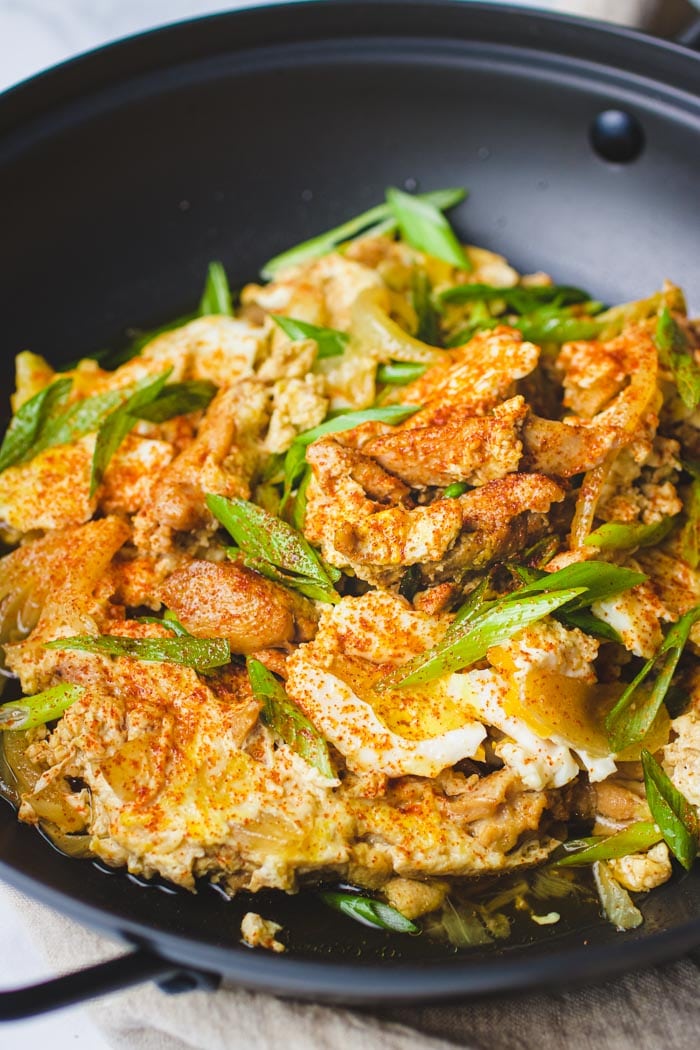
Oyako Donburi (Japanese Chicken Rice Bowl with Eggs)
I Heart Umami fans have probably guessed how much I adore Japanese food. So much so that I have a collection of low carb Japanese recipes to satisfy my cravings. Growing up in Taiwan, because Taiwan was Japan’s colony for over 50 years, Taiwanese people enjoy Japanese food and travel to Japan often and Oyako Donburi is one of the meals that we like to order in Japanese restaurants!
Nothing beats a one bowl meal with juicy chicken, sweet onions, and soft eggs. Part of the charm is watching the oyakodon broth seeps through layers of fluffy rice. Take a big spoon and deep through the layers of delicious goodness – a little bit of everything plus the sweet broth – every bite is full of flavor.
Oyako Donburi is one of those meals that satisfies your soul and it warms your body inside out. No wonder it’s loved by both adults and kids.
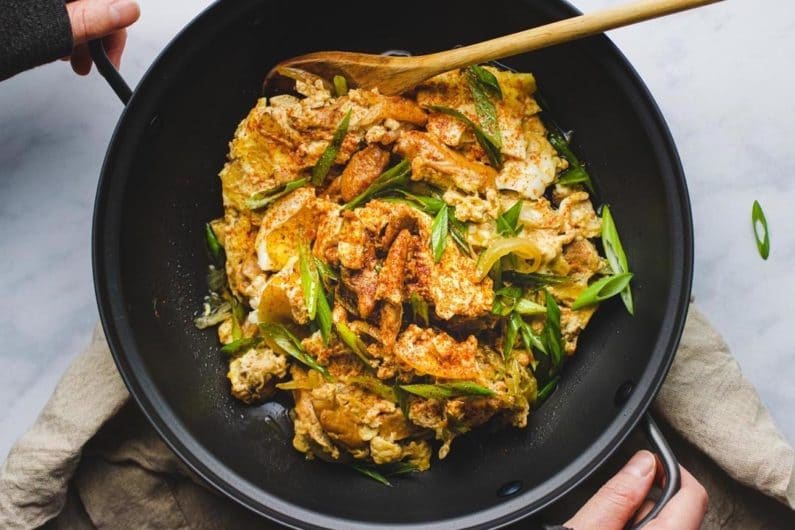
What Does Oyakodon Mean?
Oyakodon (親子丼), literally means “parent and child bowl”. It’s a Japanese rice bowl dish with chicken, eggs, and scallions, simmered in chicken and dashi broth, and served on top of a bowl of steamed white rice. The name of the dish is cute and romantic because chicken and eggs are related just like parents and a child.
What Does Donburi Mean?
Donburi (丼) literally is a Japanese rice bowl dish usually consists of fish or meat with vegetables simmered together and served over rice.
Oyako Donburi means chicken and eggs in rice bowls.
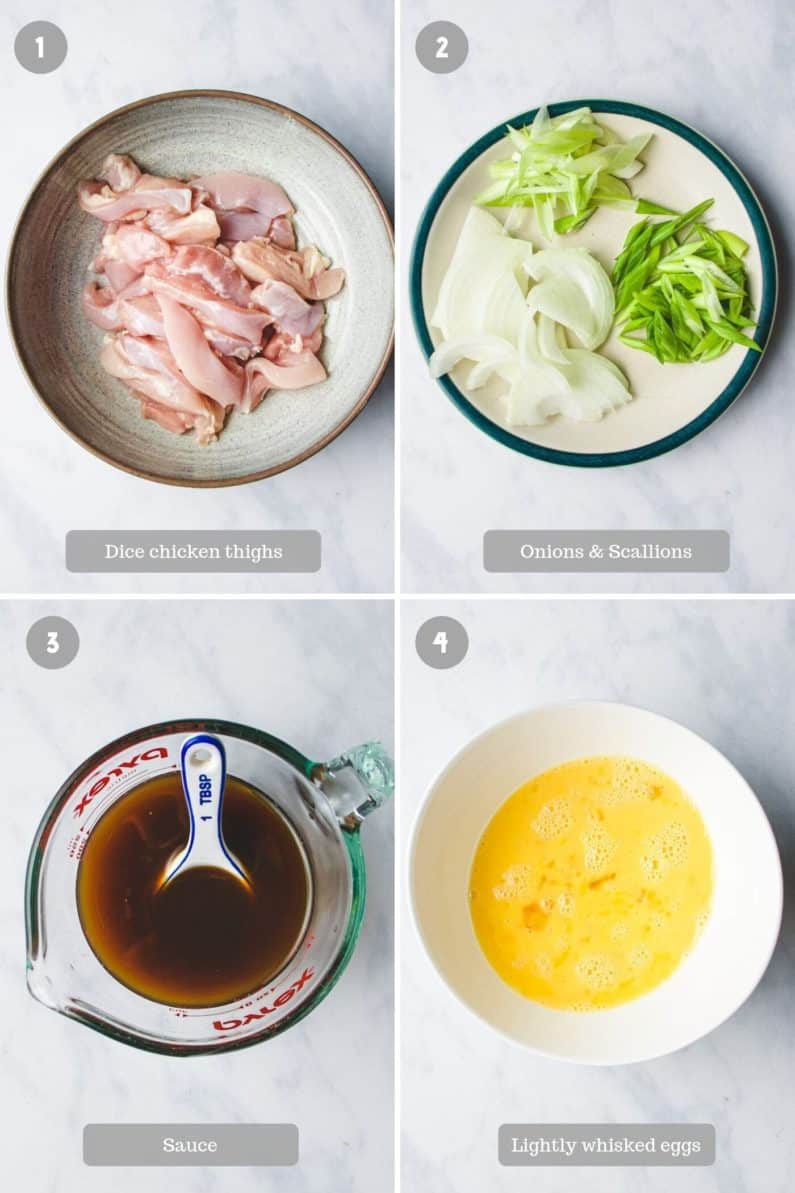
What Does Oyakodon Taste Like?
Oyakodon (or Oyako Donburi) tastes sweet and savoy. The sweet flavor comes from the onion and chicken thighs, simmered in a savory dashi broth. To keep the sauce simple and gluten, soy-free, I modified the original recipe. I have to say that from my years of eating Japanese Oyakodon my Paleo version is just as delicious. One bite, you’ll taste all the delicious flavor without knowing it’s made Paleo friendlyl
How To Make Oyakodon?
Traditionally, oyakodon recipe starts with simmering chicken in dashi broth. Once the broth simmers, add sliced chicken thighs, onion slices, and scallions. There’s no oil in Oyako Donburi. The eggs are lightly whisked but the egg white and yolk are still distinct.
To make Paleo Oyakodon without soy and gluten, here are my workaround:
- Saute the onion slices to add flavor base to the broth.
- Add the sliced chicken thighs and scallions.
- Add chicken stock with rice vinegar, balsamic vinegar, and coconut aminos to mimic the sweet, savory, and a little tart flavor from the mirin and the dashi broth.
- Once simmers, allow the pot to cool to room temperature before re-boiling it again. (see my reasons below).
- Lightly whisk the eggs and slowly drizzle it into the pot.
- Once the eggs become firmer, serve it over a bowl of cauliflower rice (low carb) or steamed white rice (gluten-free).
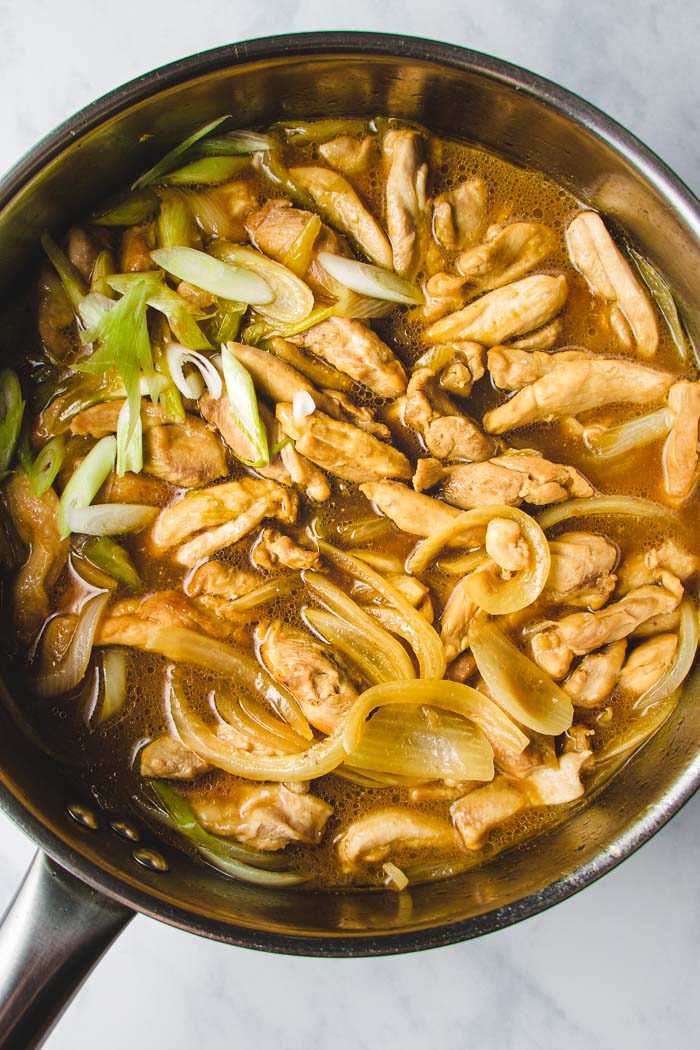
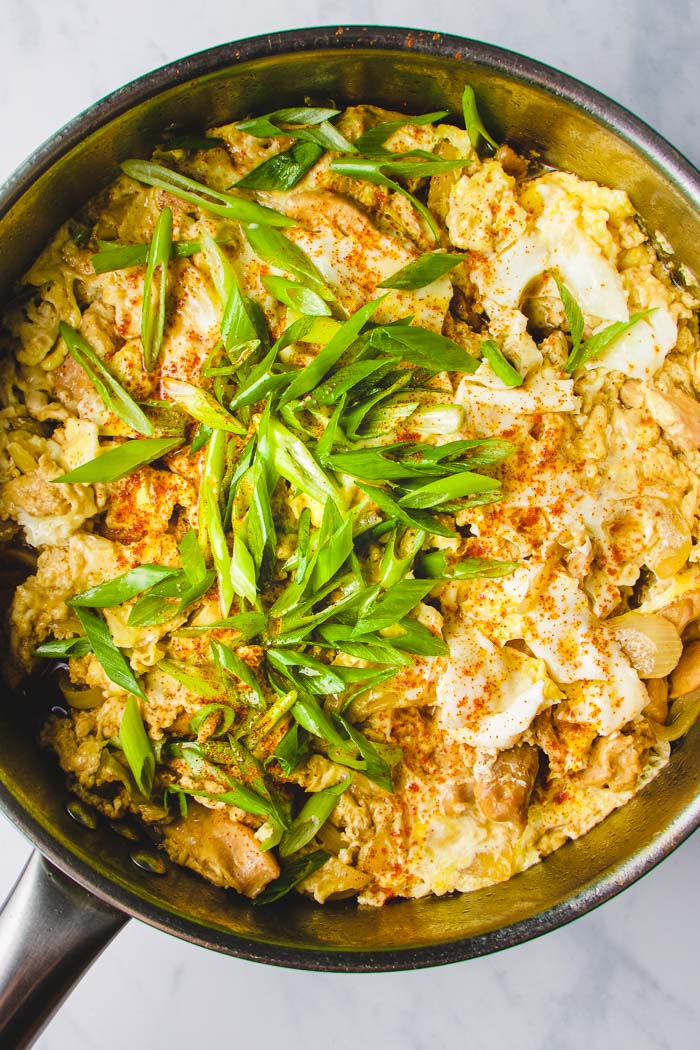
My workaround Paleo method to make Oyakodon recipe is different than most traditional Japanese recipe and here’s why:
- First, I saute the onions as opposed to simmering it.
- Second, I include resting time (cooling time) to allow the chicken absorb more flavor before bringing the broth to boil again.
This is because the traditional recipes on the internet use dashi broth (or dashi powder) and soy sauce. Both ingredients have much stronger and intense flavor therefore it doesn’t need resting time.
My workaround uses all simple ingredients like rice vinegar, balsamic vinegar, and coconut aminos (soy-free soy sauce substitute). The flavor intensity is not as strong so a quick resting (cooling) time will help deepen the flavor.
My workaround ingredients are also common for my readers to find in the States, especially for people who are gluten-free, grain-free, and prefer low carb.

Serve the Oyakodon Recipe Chicken Rice Bowl with –
- Bok Choy Salad
- Asian Coleslaw
- Mung Bean Sprouts Salad
- Roasted Cauliflower Recipe
- Roasted Brussels Sprouts
- Cauliflower Gratin
- Lemon Garlic Broccoli
- Grilled Peach Salad
More Japanese-inspired Paleo Recipes –
- Whole30 Tantanmen Ramen (cold weather perfect!)
- Cold Ramen Noodles (for hot summer!)
- Temaki Sushi Hand Rolls
- Soot Sprite Cookies (Keto sweets for adults and kids!)
- Meal Prep Gyoza Meatballs
- More Paleo Dinner Recipes
- More Paleo Japanese-inspired Recipes
Watch How To Make Oyako Donburi!
Friends! This Japanese Chicken Rice Bowl (Oyakodon recipe) is absolutely delicious and super easy to make. With 10 ingredients or less, this is the ultimate Japanese one pot meal. Pair it with a simple side dish or pick a Whole30 salad dressing. For people who don’t mind little carb, serve over steamed white rice, for people who want to keep it low carb, serve with cauliflower fired rice or mashed sweet potatoes. See…It’s very versatile!
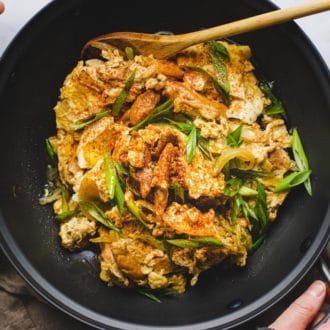
Oyakodon Chicken Rice Bowl (Gluten-Free, Paleo)
Video
Ingredients
- 1 medium yellow onion, sliced
- 4 bulbs scallions, diced diagonally. Separate white & green parts
- 2 lbs chicken thighs, skinless boneless, slice to bite-size small chunks or thin strips
- 4-5 large eggs, lightly whisked with yolk and white are still distinct
Oyakodon Broth Seasonings:
- ⅔ cup chicken stock/broth
- 4-5 tbsp coconut aminos
- 1 tsp aged balsamic vinegar
- 2 tsp rice vinegar
Other:
- Avocado oil
- Coarse salt
- Japanese red chili powder, Shichi-mi tōgarash(optional)
Instructions
- Prepare the onions, scallions, chicken, and eggs. In a bowl, combine chicken broth, coconut aminos, aged balsamic and rice vinegar.
- Cook: In a well-heated skillet, preferably 10-12 inch skillet, add 2 tbsp oil. Lower the heat to medium. Add sliced onion. Season with a pinch of salt and saute until the onion turns slightly translucent, about 1 minute.
- Add chicken and white scallion parts. Season with 2 pinches of salt. Give a quick saute then add the broth. Distribute the chicken in a single layer so it's in touch with the broth. Half cover the skillet with a lid so that the steam can escape. Let the broth simmer over medium/ medium-low heat until it reaches a gentle boiling state, about 4-5 mins. Use chopsticks or tong to move/flip around the chicken pieces to ensure even cooking.
- Resting/cooling: Once the broth come to a gentle boiling state, turn off the heat. Set the whole skillet aside, uncovered to let cool for 15-20 minutes. Make sure the meat is in contact with the broth in order to absorb more flavor.
- Eggs: After resting, reheat the skillet to bring it back to a gentle boiling state. Use chopsticks or a fork against one end of the bowl and slowly and evenly drizzle in eggs. Let the eggs stand for a few seconds until they are cooked to desired doneness (1 minute for runny eggs, 3 minutes for medium-firm eggs).
- Serve: Ladle a few spoonfuls of chicken, eggs, and the broth over cauliflower rice. Allow the broth to sip through the rice for extra flavor. Top with green scallion parts and dash of Japanese red chili powder, if using.
Notes
- The 15-20-minute rest (or even longer if you have time) allows the chicken to soak up more flavor from the delicious broth.
- This is a slightly more soupy-ish dish. The broth will become thicker (will gel) after refrigerated the next day.
- To keep the chicken pieces tender (cooked through but not tough/dry), I recommend using chicken thighs and pay attention to the stovetop temperature. Cook in medium steady heat to keep the meat tender.
Nutrition
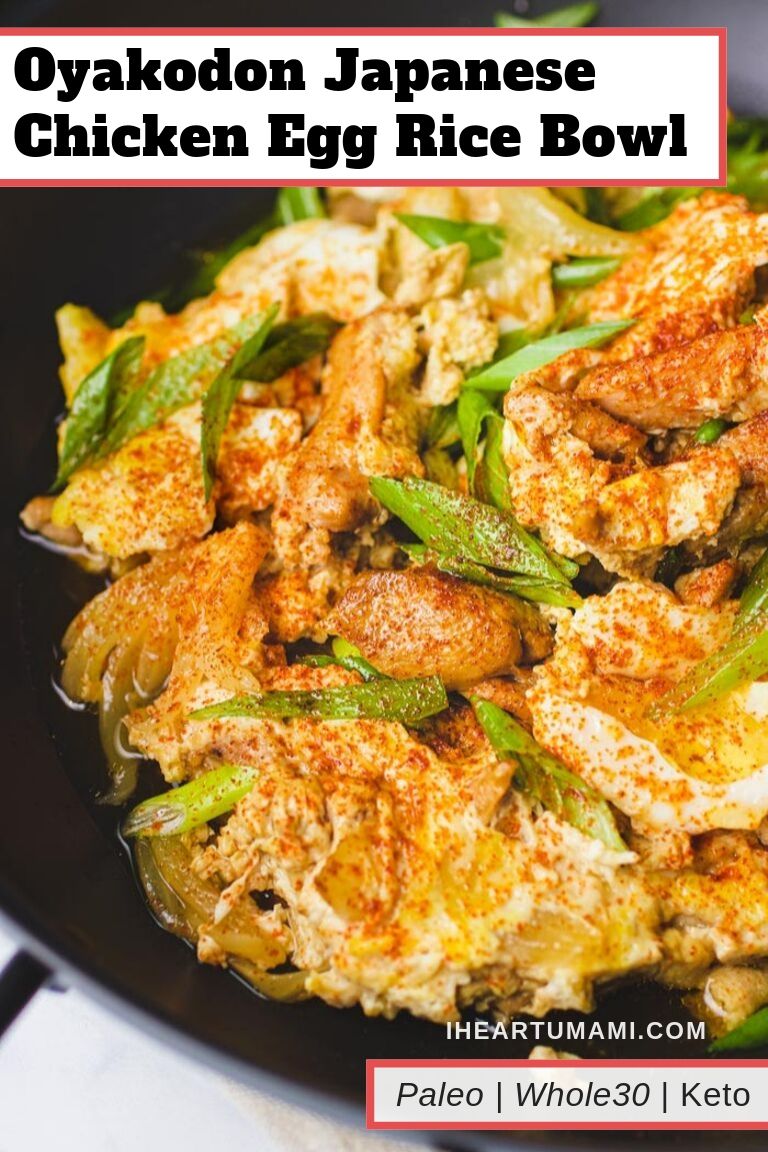

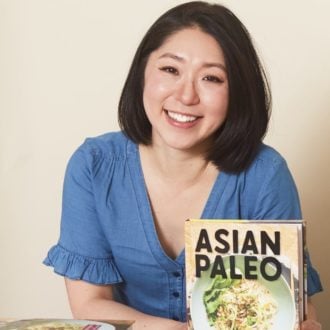
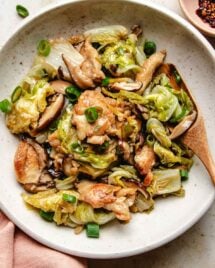
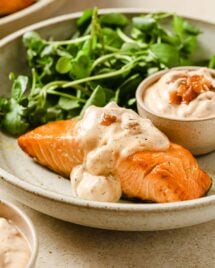
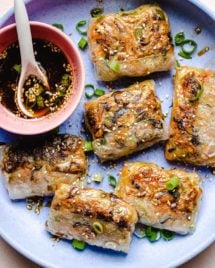
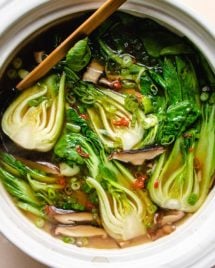


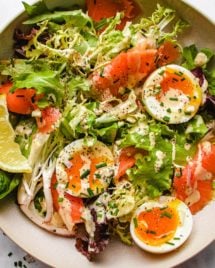
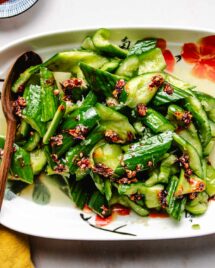
After just getting back from a 3-week Asia trip (Thailand and Japan) this recipe was exactly what I needed to feel like I was still on my trip, just back home in Texas! It was such a simple, quick, and easy recipe that I made for 4 days of meal prep for my lunch at work! Awesome recipe.
So happy to hear. Thank you, Lindsey! I miss Japan, too!
Hello! My family and I love your recipes, thank you so much! I have been slowly incorporating asian ingredients in my mainly euro ingredient pantry. Can you tell me what effect adding coconut aminos has on recipes? Also, which brand do you use?
Hi Lina, thank you for your message. Coconut aminos is a soy-free and wheat-free (gluten-free) soy sauce substitute. It tastes lighter and naturally sweeter than soy sauce because it’s made from coconut nectar. I ordered mine on Amazon and health grocery stores (such as WholeFoods and TraderJoe’s) carry them, too. If you can’t find it and if you are okay with it – try gluten-free and low sodium tamari. Tamari is much saltier and less sweet than coconut aminos so I recommend reduce the quantity by half as a start. Add more if you feel it’s not salty enough. I made a video about it. Check it out here – https://www.youtube.com/watch?v=kb8qAGY-DqI My Shop Page on my site also has a link to the product and products I use often. Hope this helps. Thank you!
This looks so good, I could easily eat it for breakfast lunch and dinner!
Loved this comforting delicious recipe! Will definitely make again soon!
So happy to hear. Thank you!
I am so much looking forward to making it tomorrow. Got all of the ingredients already.
I am absolutely making this! These are all my favorite flavors. Thanks for what looks like an amazing recipe!
That’s awesome!
I’ve never heard of this dish, but it’s definitely my kinda meal. The broth sounds fantastic!
OMG we made this dish tonight and even my super picky 3-year old LOVE this dish. I can’t believe how easy it is to make. It comes together quickly and tastes even better the next day just like Chihyu said. Thank you for this great recipe. Our whole family love it!
So happy to hear. Thanks so much, Lin!
So many of my favorite flavors! Can not wait to try this paleo chicken & egg dish for dinner this week – thank you!!!
Love the explanation of the name! And what a yummy looking meal that the whole family, parent AND child could enjoy together 😉
I love how approachable you make your dishes. Looking at the pic I’d assume it was complicated but I am totally trying this!
I loved how simple this was to make! It hit all the right spots for flavour and my family loved it 🙂
I made this tonight with some cauliflower rice and zucchini and it was so goooooood and so simple to make! I love that I can still have my oyakodonburi while eating paleo, thank you so much❤️
Thank you, Deana!
I learned so much from your post. Thank you for sharing Oyakodon with us; it is new to me, so I also appreciate all of your tips.
Thank you so much!
This sounds super easy and totally like something my family would gobble up! Thanks for the recipe!
I’ve never had this & I’m so excited to try it. It looks so yummy & simple to prepare!
We love Oyakodon – It’s basically Japanese style Chicken and onion stew. So delicious!
This looks absolutely delicious perfect healthy meal
Omg – this looks so good! I love me a good Oyakodon bowl – love that this one is paleo.
Super simple to throw together for a quick meal, and really so delicious! We all really loved it!
Just wanted to say that I’m doing the Whole30 next month and I’m so glad I found your site! I can’t wait to make this oyakodon and your recipe for gochujang, among many others. I appreciate your creativity when it comes to converting all of my favorite foods! I never would have thought of these ideas.
Thanks so much. So happy to hear!